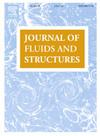悬停襟翼飞行中流固耦合在机械感觉中的作用
IF 3.4
2区 工程技术
Q1 ENGINEERING, MECHANICAL
引用次数: 0
摘要
昆虫的翅膀以其复杂的结构和功能而闻名,在拍打运动中会固有地变形。这些变形可分为弦向弯曲、展向弯曲和从根部到尖端扭曲,这些变形是由不均匀的脉纹分布、气动载荷和机翼惯性引起的。至关重要的是,这种变形在提高空气动力学性能和机械感觉功能方面起着至关重要的作用。为了研究机翼结构、非定常空气动力学和力学感觉之间的复杂相互作用,我们开发了一个完全耦合的三维流固耦合求解器。该框架集成了用于求解流场的内部Navier-Stokes方程求解器和用于求解实体结构动力学的开源Vega FEM代码。我们的FSI模拟显示,脉状结构通过实现复杂的变形模式显著提高了气动效率。中等刚度(降低刚度K = 3.94)值的机翼在升力产生和能源效率之间达到最佳平衡,优于刚性和过度柔性的配置(与刚性机翼相比,升力产生提高6%,动力效率提高89%)。与均匀翼相比,在K = 3.94时,脉流结构翼的升力降低了8%,但动力效率提高了25%。此外,应变能密度的时间历程与气动力的变化趋势密切相关,表明嵌入式机械传感器感知的局部应变能具有预测气动力的潜力。这一发现强调了昆虫翅膀非定常空气动力学和感觉反馈之间的直接功能联系。这些结果强调了翼刚度、脉纹结构和非定常空气动力学在塑造昆虫翼的气动性能和感觉性能方面的关键作用。通过阐明昆虫如何从翅膀的灵活性中获得空气动力学和感官上的好处,本研究为昆虫的飞行机制提供了有价值的见解,并为设计高效和自适应的扑翼微型飞行器提供了灵感。本文章由计算机程序翻译,如有差异,请以英文原文为准。
Role of fluid-structure interactions in mechanosensation during hovering flapping flight
Insect wings, known for their intricate structure and function, inherently deform during flapping motion. These deformations can be classified into chordwise cambering, spanwise bending, and root-to-tip twisting, arising from non-uniform venation distribution, aerodynamic loading, and wing inertia. Crucially, such deformations play a vital role in enhancing both aerodynamic performance and mechanosensory function. To investigate the complex interplay between wing structure, unsteady aerodynamics, and mechanosensation, we developed a fully coupled three-dimensional fluid-structure interaction (FSI) solver. This framework integrates an in-house Navier-Stokes equations solver for resolving the flow field with the open-source Vega FEM code to solve the solid structure dynamics. Our FSI simulations reveal that venation structures significantly enhance aerodynamic efficiency by enabling complex deformation patterns. Wings with moderate stiffness (reduced stiffness K = 3.94) values strike an optimal balance between lift generation and energy efficiency, outperforming both rigid and excessively flexible configurations (6 % higher lift generation and 89 % higher power efficiency, compared to rigid wings). In contrast with uniform wings, at K = 3.94, wings with venation structure generate 8 % less lift but the power efficiency is 25 % higher. Additionally, the time history of strain energy density closely mirrors the trend of aerodynamic forces, suggesting that local strain energy sensed by embedded mechanosensors could potentially predict aerodynamic forces. This finding highlights a direct functional link between unsteady aerodynamics and sensory feedback in insect wings. These results underscore the critical roles of wing stiffness, venation structures, and unsteady aerodynamics in shaping both the aerodynamic and sensory performance of insect-inspired wings. By elucidating how insects derive aerodynamic and sensory benefits from wing flexibility, this study provides valuable insights into insect flight mechanisms and offers inspiration for the design of efficient and adaptive flapping-wing Micro Air Vehicles.
求助全文
通过发布文献求助,成功后即可免费获取论文全文。
去求助
来源期刊

Journal of Fluids and Structures
工程技术-工程:机械
CiteScore
6.90
自引率
8.30%
发文量
173
审稿时长
65 days
期刊介绍:
The Journal of Fluids and Structures serves as a focal point and a forum for the exchange of ideas, for the many kinds of specialists and practitioners concerned with fluid–structure interactions and the dynamics of systems related thereto, in any field. One of its aims is to foster the cross–fertilization of ideas, methods and techniques in the various disciplines involved.
The journal publishes papers that present original and significant contributions on all aspects of the mechanical interactions between fluids and solids, regardless of scale.
 求助内容:
求助内容: 应助结果提醒方式:
应助结果提醒方式:


